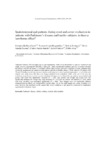Mostrar o rexistro simple do ítem
Spatiotemporal gait patterns during overt and covert evaluation in patients with Parkinson’s disease and healthy subjects: is there a hawthorne effect?
| dc.contributor.author | Robles-García, Verónica | |
| dc.contributor.author | Corral Bergantiños, Yoanna | |
| dc.contributor.author | Espinosa, Nelson | |
| dc.contributor.author | Jácome, M. A. | |
| dc.contributor.author | García-Sancho, Carlos | |
| dc.contributor.author | Cudeiro, Javier | |
| dc.date.accessioned | 2018-04-04T10:32:38Z | |
| dc.date.available | 2018-04-04T10:32:38Z | |
| dc.date.issued | 2015 | |
| dc.identifier.citation | Robles-García V, Corral-Bergantiños Y, Espinosa N, et al. Spatiotemporal gait patterns during overt and covert evaluation in patients with Parkinson’s disease and healthy subjects: is there a hawthorne effect?. J Appl Biomech. 2015; 31(3):189-194 | es_ES |
| dc.identifier.issn | 1065-8483 | |
| dc.identifier.issn | 1543-2688 | |
| dc.identifier.uri | http://hdl.handle.net/2183/20364 | |
| dc.description.abstract | [Abstract] Parkinson's disease (PD) and aging lead to gait impairments. Some of the disturbances of gait are focused on step length, cadence, and temporal variability of gait cycle. Under experimental conditions gait can be overtly evaluated, but patients with PD are prone to expectancy efiects; thus it seems relevant to determine if such evaluation truly reflects the spontaneous gait pattern in such patients, and also in healthy subjects. Thirty subjects (15 subjects with PD and 15 healthy control subjects) were asked to walk using their natural, preferred gait pattern. In half ot the trials subjects were made aware that they were being evaluated (overt evaluation), while in the rest of the trials the evaluation was performed covertly (covert evaluation). During covert evaluation the gait pattern was modified in all groups. Gait speed was significantly increased (P = .022); step cadence and average step length were also significantly modified, the average step length increased (P - .002) and the cadence was reduced (P < .001). Stride cycle time variability was unchanged significantly (P = .084). These changes were not significantly different compared between elderly and young healthy controls either. Due to the small sample size, a note of caution is in order; however, the significant results suggest that covert evaluation of gait might be considered to complement experimental evaluations of gait. | es_ES |
| dc.description.sponsorship | This work was supported by Xunta de Galicia (Consellería de Educacion-2007/000140-0, Dirección Xeral de I+D+i; 2010-2012 and Ayudas a Grupos Consolidados, Consellería de Educación, 2013), Spain; and V. Robles-García and Y. Corral-Bergantiños are funded by the FPU-MECD AP2010-2774 & AP2010-2775, Spain | es_ES |
| dc.description.sponsorship | Xunta de Galicia; 2007/000140-0 | |
| dc.description.sponsorship | info:eu-repo/grantAgreement/MECD/Programa Nacional de Formación/AP2010-2774/ES | |
| dc.description.sponsorship | info:eu-repo/grantAgreement/MECD/Programa Estatal de Promoción del Talento y su Empleabilidad/AP2010-2775/ES | |
| dc.language.iso | eng | es_ES |
| dc.publisher | Human Kinetics | es_ES |
| dc.relation.uri | http://dx.doi.org/10.1123/jab.2013-0319 | es_ES |
| dc.subject | Effect modifier | es_ES |
| dc.subject | Elderly | es_ES |
| dc.subject | Methods | es_ES |
| dc.subject | Parkinson's disease | es_ES |
| dc.subject | Walking | es_ES |
| dc.title | Spatiotemporal gait patterns during overt and covert evaluation in patients with Parkinson’s disease and healthy subjects: is there a hawthorne effect? | es_ES |
| dc.type | info:eu-repo/semantics/article | es_ES |
| dc.rights.access | info:eu-repo/semantics/openAccess | es_ES |
| UDC.journalTitle | Journal of Applied Biomechanics | es_ES |
| UDC.volume | 31 | es_ES |
| UDC.issue | 3 | es_ES |
| UDC.startPage | 189 | es_ES |
| UDC.endPage | 194 | es_ES |
Ficheiros no ítem
Este ítem aparece na(s) seguinte(s) colección(s)
-
GI-NEURO - Artigos [132]
-
INIBIC-NEURO - Artigos [48]






